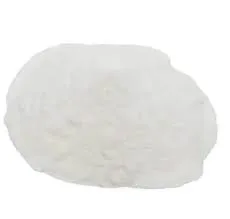
Sep . 08, 2024 05:33 Back to list
hydroxyethyl cellulose sds
Hydroxyethyl Cellulose (HEC) Safety Data Sheet (SDS)
Hydroxyethyl cellulose (HEC) is a versatile, non-ionic water-soluble polymer derived from cellulose. It is widely used in various applications, including pharmaceuticals, cosmetics, food products, and construction materials, due to its excellent thickening, gelling, and film-forming properties.
Chemical Identity and Composition
Hydroxyethyl cellulose is produced through the etherification of cellulose with ethylene oxide. Its chemical formula can be represented as C2H6O2·(C6H10O5)n, where 'n' indicates the degree of polymerization. HEC is primarily characterized by its hydroxyethyl substitution, which increases its solubility in water while providing a non-toxic profile.
Physical and Chemical Properties
HEC is a white, odorless powder that is stable under normal conditions. It has a variety of molecular weights, enabling it to exhibit different viscosity levels in solution. It is soluble in cold and hot water, forming a clear, viscous gel. Additionally, it is biodegradable and environmentally friendly, making it a preferred choice in sustainable formulations.
Health Hazards
According to the Safety Data Sheet (SDS) for hydroxyethyl cellulose, it is generally regarded as safe for use in various applications. However, Standard Precautions should still be followed when handling the material. Inhalation, skin contact, or ingestion should be avoided. Although HEC is non-toxic, prolonged exposure may cause mild irritation to the skin, eyes, or respiratory system.
First Aid Measures
hydroxyethyl cellulose sds

In case of exposure, the following first aid measures are recommended
- Inhalation If inhaled, move the affected person to an area with fresh air. If respiratory symptoms persist, seek medical attention. - Skin Contact Remove contaminated clothing and wash the skin with soap and water for at least 15 minutes. If irritation occurs or persists, consult a healthcare professional. - Eye Contact Rinse cautiously with water for several minutes. If irritation or redness persists, seek medical attention. - Ingestion Rinse the mouth and drink water to dilute the substance. Do not induce vomiting unless directed by medical personnel.
Storage and Handling
Hydroxyethyl cellulose should be stored in a cool, dry place, away from strong oxidizers or heat sources to prevent degradation. It's essential to keep containers tightly closed when not in use to maintain the integrity of the product. Standard industrial hygiene practices should be observed, including wearing appropriate personal protective equipment (PPE) such as gloves and goggles.
Environmental Impact
HEC is considered environmentally friendly due to its biodegradable nature. It poses minimal risk to aquatic life and is compliant with various environmental regulations. However, any spills should be cleaned promptly to avoid water contamination.
Conclusion
Hydroxyethyl cellulose is an invaluable compound across multiple industries due to its remarkable properties and safety profile. While it is generally safe, adherence to safety guidelines outlined in its Safety Data Sheet is crucial for ensuring the well-being of individuals and the environment. As the demand for healthier and safer products increases, HEC's role in formulations is likely to expand, affirming its place as a key ingredient in sustainable practices.
-
Versatile Hpmc Uses in Different Industries
NewsJun.19,2025
-
Redispersible Powder's Role in Enhancing Durability of Construction Products
NewsJun.19,2025
-
Hydroxyethyl Cellulose Applications Driving Green Industrial Processes
NewsJun.19,2025
-
Exploring Different Redispersible Polymer Powder
NewsJun.19,2025
-
Choosing the Right Mortar Bonding Agent
NewsJun.19,2025
-
Applications and Significance of China Hpmc in Modern Industries
NewsJun.19,2025







